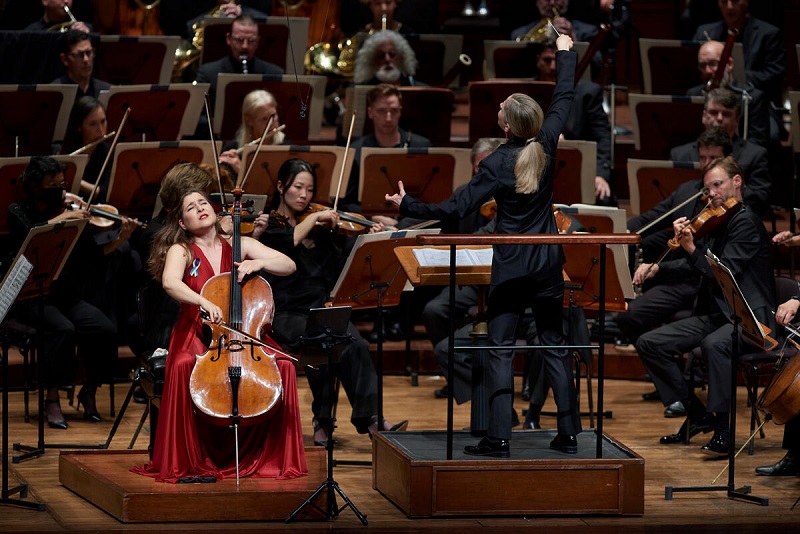
WOMEN AT SYMPHONIC FOREFRONT
Although never billed as such, the latest S.F. Symphony program unreeled a tribute to the creativity of women—as conductor, as soloist, as composer. And by the end, I found myself reaching for my seat belt during a brassy, rambunctious large-orchestra finale of modern music that, yes, even got a standing ovation May 13. Yes, that dissonant modernist Lutoslawski gets a standing ovation—imagine that!
The woman composer in a more dulcet mode was Lili Boulanger, sister of the legendary composition professor Nadia B. who had taught a passel of eminent American composers in roughly 1920-1950. A very promising composer, Lili however had fallen ill and died before her 25th birthday, to be added to the list of notable past composers who died far too young—Mozart, Schubert, Mendelssohn, Arriaga. She was remembered here for “D’un soir triste” (From a Sad Evening). Stylistically this short opus stands stylistically between late Debussy and “Pierrot Lunaire” from the World War One era—mystical, fog-shrouded, vaguely swathed in dissonance. That fog, so difficult to compose, enhanced so much French music of that time, providing intrigue as it raised more questions than it answered.
To paraphrase the late critic Harold Schonberg, when a new French conductor announced he’d remove all the fog off his concert music: “Actually, we’ve rather appreciated that fog.”
The remainder of the program was best watched with blindfolds on the patrons: powerful musically, but very distracting visually. The interesting American expat making her career in Europe, Karina Canellakis, gesticulated like an action painter from the podium, sometimes leaving the ground completely with her inordinate energy at climaxes. Even more striking was a superb cellist (and MacArthur Fellowship “genius grant” awardee) Alisa Weilerstein, who appeared to be in total agony with her grimaces during the large solo part of Richard Strauss’ “Don Quixote,” which entails no musical agony whatsoever.
There may be a moral in all this: When in show business, you DO show business!
Strauss had composed his meaty and meticulous 21-minute tone poem on reading Cervantes, following the many turns of plot of the comically deluded knight Quixote. The extremes of lethargy and high energy reflected the idiosyncrasies and mercurial mood changes of the meandering and misguided knight, essentially as though Quixote were a heroic figure. The tale was carried forward by a large orchestra paired with Weilerstein, who performed the high fingerboard positions intently and unerringly, with a generous vibrato.
A subordinate solo was offered by Jonathan Vinocur in the too-often-unsung viola section. Among others, an emotional Weilerstein was mightily impressed, rushing over to hug him at the conclusion.
The orchestra’s performance was not quite flawless, but featured nice solo surprises: Robert Ward on French horn, Edward Stephan on timpani, not one but two fill-in harpists, and one performer on that rarity, the Wagner (or tenor) tuba. Surprisingly, Strauss opted to ignore known Spanish music and styling in this reiteration. And if you had wanted comic effects, this was putative comedy essayed by a very serious musician.
Why do we hear so little of Richard Strauss and his huge tone poems these days? Most likely as he is harshly judged for his wishy-washy politics, since for a high honorary post he was both hired and fired by the Nazis in the 1930s and ‘40s. Arturo Toscanini judged him severely, once stating “To Richard Strauss, the composer, I take off my hat. To Richard Strauss, the man, I put it on again.”
By that degree of severity applied to composers’ private lives, we’d also have to downplay or ban music by the likes of Liszt, Wagner, Gesualdo, and certain others, who were merely plagiarists. Maybe even Shostakovich, who wrote music used for Soviet propaganda.
The night’s mind-blowing impact was from the “Concerto for Orchestra” (1954) by Witold Lutoslawski, who with Penderecki was responsible for contemporary Polish music emerging from the shadow of Communist suppression (A figure who himself has appeared on the SFS podium in person as conductor). In character and style, this large-canvas work comes perhaps closest to Bartok’s similarly titled opus, and to symphonic efforts of Shostakovich, but it is yet more brassy and rambunctious than either, with high-energy explosives in the score. Apart from moments of barely audible will-o-the-wisp string sounds, this epic 31-minute landmark of intensity was, if not replaying battles of World War Two Poland, surely reflected the pressure of the heavy bombardments still rattling around the brain years later.
Standing in as the violin’s leader was assistant concertmaster Wyatt Underhill, known by patrons for his gorgeous violin tone earlier (unheard or lost on this eventful night). The limited Davies attendance was attributable to programming unfamiliar music throughout.
SAN FRANCISCO SYMPHONY with guest conductor Karina Canellakis and cellist Alisa Weilerstein, through May 15 at Davies Hall, S.F. For info: (415) 864-6000, or go online: www.sfsymphony.org.